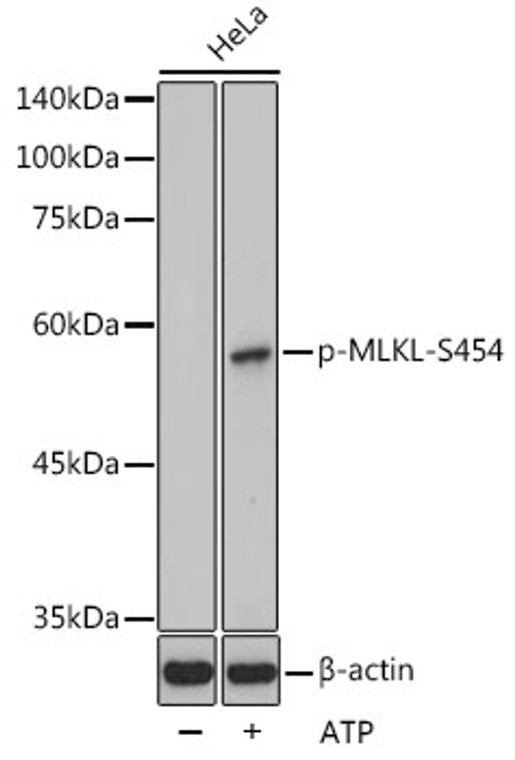| Host: |
Rabbit |
| Applications: |
WB/ELISA |
| Reactivity: |
Human/Mouse/Rat |
| Note: |
STRICTLY FOR FURTHER SCIENTIFIC RESEARCH USE ONLY (RUO). MUST NOT TO BE USED IN DIAGNOSTIC OR THERAPEUTIC APPLICATIONS. |
| Clonality: |
Polyclonal |
| Conjugation: |
Unconjugated |
| Isotype: |
IgG |
| Formulation: |
PBS with 0.05% Proclin300, 50% Glycerol, pH 7.3. |
| Purification: |
Affinity purification |
| Concentration: |
Lot specific |
| Dilution Range: |
WB:1:500-1:2000ELISA:Recommended starting concentration is 1 Mu g/mL. Please optimize the concentration based on your specific assay requirements. |
| Storage Instruction: |
Store at-20°C for up to 1 year from the date of receipt, and avoid repeat freeze-thaw cycles. |
| Gene Symbol: |
MLKL |
| Gene ID: |
197259 |
| Uniprot ID: |
MLKL_HUMAN |
| Specificity: |
A synthetic phosphorylated peptide around S454 of human MLKL (NP_689862.1). |
| Immunogen Sequence: |
HDPSVR |
| Post Translational Modifications | Phosphorylation by RIPK3 induces a conformational switch that is required for necroptosis. It also induces homotrimerization and localization to the plasma membrane. |
| Function | Pseudokinase that plays a key role in TNF-induced necroptosis, a programmed cell death process. Does not have protein kinase activity. Activated following phosphorylation by RIPK3, leading to homotrimerization, localization to the plasma membrane and execution of programmed necrosis characterized by calcium influx and plasma membrane damage. In addition to TNF-induced necroptosis, necroptosis can also take place in the nucleus in response to orthomyxoviruses infection: following activation by ZBP1, MLKL is phosphorylated by RIPK3 in the nucleus, triggering disruption of the nuclear envelope and leakage of cellular DNA into the cytosol.following ZBP1 activation, which senses double-stranded Z-RNA structures, nuclear RIPK3 catalyzes phosphorylation and activation of MLKL, promoting disruption of the nuclear envelope and leakage of cellular DNA into the cytosol. Binds to highly phosphorylated inositol phosphates such as inositolhexakisphosphate (InsP6) which is essential for its necroptotic function. |
| Protein Name | Mixed Lineage Kinase Domain-Like ProteinHmlkl |
| Database Links | Reactome: R-HSA-3295583Reactome: R-HSA-5213460Reactome: R-HSA-5675482Reactome: R-HSA-9686347 |
| Cellular Localisation | CytoplasmCell MembraneNucleusLocalizes To The Cytoplasm And Translocates To The Plasma Membrane On Necroptosis InductionLocalizes To The Nucleus In Response To Orthomyxoviruses Infection |
| Alternative Antibody Names | Anti-Mixed Lineage Kinase Domain-Like Protein antibodyAnti-Hmlkl antibodyAnti-MLKL antibody |
Information sourced from Uniprot.org
12 months for antibodies. 6 months for ELISA Kits. Please see website T&Cs for further guidance








